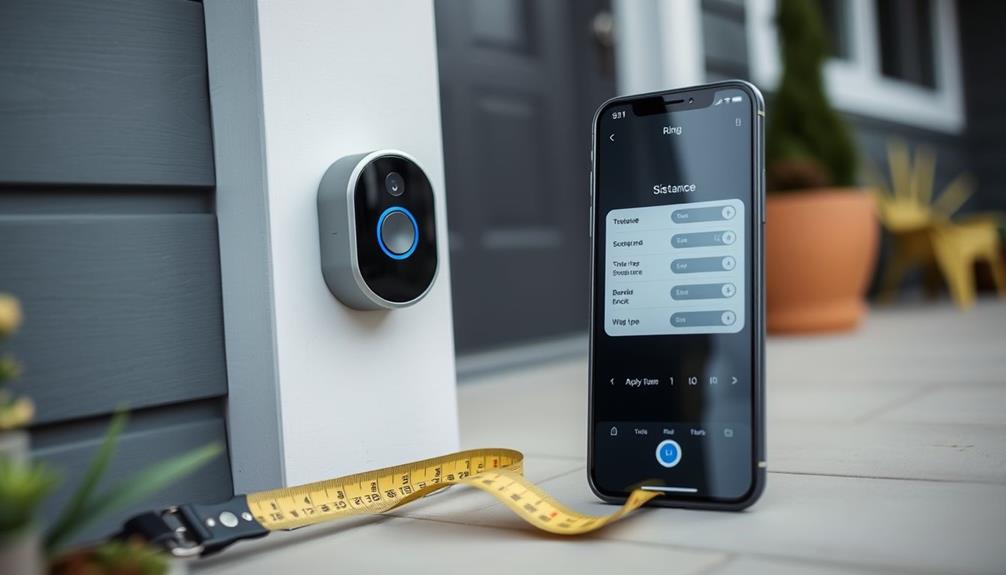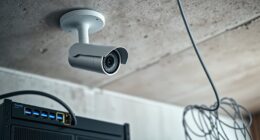To install your Ring Doorbell on siding, start by choosing a suitable location—ideally near your front door and about 48 inches high. Check the siding for any damage before proceeding. You'll need a power drill, a level, a wedge kit for better angle placement, and the included screws. Secure the wedge with masking tape to guarantee it's level, then drill and fasten the mounting bracket. Connect the doorbell, and make sure it's within your Wi-Fi range for peak operation. For tips on common issues and best practices, there's a lot more to explore! Once the mounting bracket is securely attached, snap the Ring Doorbell onto it and tighten the security screws provided. When **installing Ring Doorbell on vinyl siding**, ensure that the screws are drilled into the flatliest possible section to prevent misalignment. Finally, test the doorbell’s functionality through the Ring app, and adjust settings as needed for optimal performance.
Key Takeaways
- Choose a location near the front door at a height of 48 inches for optimal video capture and minimal obstructions.
- Inspect and repair any damage to the siding to ensure a secure and stable installation.
- Use a wedge kit for angled installation on sloped surfaces to enhance video quality and reduce false alerts.
- Ensure the Ring Doorbell is within Wi-Fi range and test the signal strength before final installation.
Choosing the Right Location
When choosing the right location for your Ring Doorbell, pick a spot near your front door that provides a clear view of visitors and packages while being close to your existing doorbell wiring, if you have it.
Aim to install the doorbell at about 48 inches from the ground for ideal video capture and accessibility. This height allows you to easily reach the device while ensuring that it captures the best angle for monitoring.
To enhance your entryway's charm, consider incorporating rustic elements that complement your home's overall style, such as those found in modern farmhouse design.
Also, avoid placing the doorbell in areas obstructed by trees, plants, or other structures that could block the camera's view. A clear line of sight is essential for effective surveillance.
Additionally, consider the direction of sunlight; installing the doorbell facing away from direct sunlight prevents glare and improves motion detection.
Required Tools and Materials

To successfully install your Ring Doorbell, you'll need a few essential tools and materials on hand. Gathering these items before starting the installation will make the process smoother and more efficient.
Here's a quick overview of the required tools and materials:
| Tool/Material | Purpose | Notes |
|---|---|---|
| Power Drill | Drilling holes into the siding | Verify it's charged |
| Level Tool | Confirm the doorbell is mounted straight | Essential for alignment |
| Wedge Kit | Angled installation on sloping siding | Helps to face doorbell forward |
| Masking Tape | Temporarily position the bracket or wedge | Easy to remove after drilling |
Make certain you have screws handy, as the installation kit typically includes these. Using the mounting level provided will guarantee a straight installation, preventing any misalignment. Having these tools ready will help you tackle the installation efficiently, so you can enjoy the features of your new Ring Doorbell in no time!
Assessing Siding Condition

How well is your siding holding up? Before you install your Ring doorbell, it's vital to evaluate the siding condition.
Start by inspecting for any cracks, holes, or damage. These issues could require repairs that must be addressed before proceeding with installation.
If you have vinyl siding, verify it's in good shape and compatible with the mounting options you plan to use. Additionally, consider that a secure installation can enhance your home security by incorporating modern technology, such as that found in garage door openers.
Look for loose or unstable sections, as these can affect the stability of your doorbell. If your siding shows signs of wear or damage, consider contacting a professional service like PJ Fitzpatrick, which has been serving the Delaware Valley since 1980.
Also, be mindful of the type of siding you have. Avoid installing the doorbell on triple wall panels or Dutch glue wall panels, since these aren't suitable for standard mounts.
Evaluating the condition of your siding is essential to guarantee a secure and effective installation. Taking the time to analyze these factors will save you from potential headaches down the line and help ensure that your new Ring doorbell functions properly.
Installation Steps Overview

Before diving into the installation, make certain you've chosen the perfect spot for your Ring Doorbell that's also within Wi-Fi range. Once you've got that sorted, it's time to prepare for installing the Ring Doorbell.
First, check the siding for any damage, as you'll need to repair any cracks or compromised areas before proceeding. It's also wise to confirm that the area you choose is well-lit for ideal visibility and security, as highlighted in essential items for a home cleaning kit.
If your home has aluminum siding or a sloping surface, you might need to use a wedge kit for the right camera angle. Tape the wedge securely in place and verify it's level before drilling starter holes through the wedge into the siding. This step is vital for a sturdy installation.
Next, install screws through the wedge and into the siding, making sure everything's tight. Finally, attach the back plate of your Ring Doorbell securely.
If you've followed these steps carefully, you're well on your way to having your Rings wired and ready to go! With the doorbell installed, you can now enjoy the added security and convenience it brings to your home.
Using a Wedge Kit

Using a Wedge Kit can greatly improve the positioning of your Ring Doorbell, especially on tricky surfaces like aluminum siding or stairs.
Proper installation can enhance your home's security and guarantee better air quality by minimizing the need for frequent adjustments, similar to how air purifiers improve indoor air quality.
It helps guarantee that the camera faces forward, reducing false motion alerts and optimizing sunlight access for better solar charger efficiency.
Let's explore the benefits and best practices for installing your Wedge Kit effectively.
Wedge Kit Benefits
A Wedge Kit positions your Ring Doorbell at the perfect angle, enhancing video capture and guaranteeing ideal performance, especially on sloped surfaces. If your home has stairs or sloping siding, using a wedge kit is crucial. It prevents the doorbell from facing upwards, which can limit its field of view and effectiveness.
With the right angle, you'll capture clearer footage of visitors and reduce blind spots. Moreover, understanding the emotional attachment in cats can help you appreciate the importance of security in your home. This kit allows for secure installation on various siding types, including aluminum and vinyl, without the need for stacking multiple kits. Not only does this simplify the installation process, but it also guarantees your Ring Doorbell functions at its best.
Moreover, a properly angled doorbell can enhance solar charger efficiency, allowing it to receive more direct sunlight. This leads to better performance and longer-lasting battery life.
In addition, using a wedge kit minimizes false motion alerts by providing a more precise camera angle. You'll enjoy fewer unnecessary notifications, making your experience with the Ring Doorbell much smoother. Overall, investing in a wedge kit is a smart choice for maximizing the effectiveness of your Ring Doorbell.
Installation Best Practices
Installing your Ring Doorbell with a Wedge Kit not only enhances its performance but also guarantees you achieve the best camera angle for ideal video capture.
When working with sloping siding, the Wedge Kit allows your doorbell to face forward rather than upwards, improving your video quality considerably. Proper installation is vital to prevent issues, much like the need for clogging remedies when dealing with plumbing problems.
Start by taping the wedge in position and ensuring it's level before drilling starter holes. This step is essential for maintaining proper alignment during installation.
Remember, stacking multiple Wedge Kits isn't recommended, as it can compromise the effectiveness of the installation and lead to improper camera positioning.
Choose a location for your Wedge Kit that receives direct sunlight, especially if you're using a solar charger. Additionally, adjust the camera angle to reduce false motion alerts, enhancing your overall experience.
Troubleshooting Common Issues

If you're facing issues with your Ring Doorbell, there are a couple of straightforward troubleshooting steps you can take.
Start by checking your connectivity and adjusting the camera angle to guarantee peak performance.
These quick fixes can help restore functionality and improve your overall experience.
Connectivity Troubleshooting Steps
Troubleshooting connectivity issues with your Ring Doorbell starts with ensuring it's within range of your Wi-Fi router for a stable internet connection. If you're facing a connectivity question, the first step is to test your Wi-Fi signal strength at the installation location using the Ring app. This will help you pinpoint any potential problems affecting the connection.
If the signal is weak, consider restarting your Wi-Fi router. This simple action can resolve temporary network issues that might be impacting your Ring Doorbell's connectivity. Additionally, check for any obstructions or interference from other electronic devices nearby. Items like microwaves or cordless phones can disrupt the Wi-Fi signal, so try to minimize these interferences.
If you've tried all these steps and the problems persist, you might need to reset your Ring Doorbell to factory settings. After resetting, re-add it to your network to see if that resolves the ongoing connectivity issues.
Camera Angle Adjustments
Adjusting the camera angle of your Ring Doorbell can greatly enhance its performance, guaranteeing a clearer view of visitors and your surroundings. To achieve the best camera angle adjustments, consider using a wedge kit to position the Ring Doorbell facing forward instead of upwards. However, avoid stacking multiple wedge kits as this can distort images and trigger false motion alerts.
To maintain the best camera alignment, keep an eye on potential obstructions like door frames or plants that may block the camera's field of view. It's also a good idea to regularly check the alignment, especially after extreme weather events. This guarantees that your Ring Doorbell continues to monitor effectively.
Here's a quick reference table to help you with common camera angle issues:
| Issue | Solution | Recommendation |
|---|---|---|
| Distorted images | Adjust the angle using a wedge kit | Use only one wedge kit |
| Obstructed view | Reposition the camera | Clear surrounding obstructions |
| Poor audio quality | Adjust for clearer sound capture | Position for two-way audio use |
Community Installation Tips

When installing a Ring doorbell, tapping into community installation tips can help you achieve a secure and effective setup tailored to your home's siding. One great way to start is by joining the Ring Community, where you can engage in discussions with fellow users who've shared their installation experiences and advice.
Consider using a wedge kit, as it allows you to angle the doorbell for ideal viewing and minimizes false motion alerts. Before drilling, try using masking tape to temporarily position the wedge. This way, you can guarantee accurate alignment without committing to holes in your siding.
If your siding is uneven or sloping, don't overlook the importance of a mounting bracket designed for those surfaces. It can greatly enhance stability and make certain your doorbell functions effectively.
Also, always inspect your siding for cracks or damage before installation; secure mounting is vital for the longevity of your device.
Safety Considerations

While community tips can help with your installation, it's crucial to ponder safety measures that protect your Ring doorbell from theft and guarantee its ideal functioning. By taking thoughtful safety considerations, you can enhance the security of your device and make certain it's always working when you need it.
- Make certain the mounting bracket is securely fastened to the siding to prevent the Ring Doorbell from being easily dislodged or stolen.
- Utilize tamper-proof screws during installation to enhance security and deter theft of the doorbell unit.
- Regularly update the Ring Doorbell's software to benefit from the latest security features and improvements.
- Monitor the camera footage consistently for any unusual activity in your vicinity, making certain prompt action can be taken if needed.
Additional Resources and Support

For a smooth installation experience, you can tap into various resources and support options provided by Ring.
Start by visiting the Ring Help Home, where you'll find a central hub for installation guidance, troubleshooting articles, and subscription service information.
If you have common concerns, check out the FAQs specifically addressing issues encountered while installing your Ring doorbell on siding.
Don't forget about the Ring Community! Here, you can engage with other users who've shared their experiences and solutions related to various siding types. This can be invaluable when you're looking for practical tips.
Additionally, user manuals and guides are available online, offering detailed instructions tailored to your specific product.
If you still can't find an answer, consider reaching out to Ring's customer support. They're ready to assist you with any installation challenges or inquiries you might have.
You can also create a Ring account to post your own questions in the community, making it easier to connect with others who might've faced similar situations.
With these resources at your disposal, you'll be well-equipped to install your Ring doorbell successfully.
Frequently Asked Questions
Can You Mount a Ring Doorbell on Siding?
Yes, you can definitely mount a Ring Doorbell on siding.
You'll want to use the right installation kit for your specific siding type, whether it's vinyl or aluminum.
If your siding panels are uneven, a siding mount can help position the doorbell correctly.
Just make sure to check compatibility with your Ring model and prepare your siding by fixing any cracks or repairs before you start drilling and securing the mount.
How to Install Ring Doorbell on Vinyl Siding Without Drilling?
Ever wondered how you can install your Ring Doorbell without drilling into your siding?
You can use an adhesive mounting solution specifically designed for vinyl siding.
Choose a mounting bracket that fits uneven surfaces, ensuring everything aligns perfectly.
Opt for a non-screwing faceplate to make installation and removal a breeze.
Just make sure the adhesive is rated for outdoor use, and regularly check its adherence to keep your doorbell secure.
How to Install a Doorbell Button on Vinyl Siding?
To install a doorbell button on vinyl siding, start by choosing a visible and accessible location.
Use a Vinyl Siding Angle Adjustment Mount to guarantee the button faces forward, even on sloped panels.
Secure the mount with screws, keeping it level for proper function.
Follow the mounting kit's instructions to avoid damaging the siding.
Can You Screw Into Vinyl Siding?
You might think you can't screw into vinyl siding without causing damage, but you actually can!
Just make sure you use screws specifically designed for vinyl to keep everything secure.
Drilling pilot holes is essential to prevent cracks, and it helps with proper alignment.
Remember to avoid over-tightening the screws; a snug fit is all you need.
If you're worried about water, a little sealant around the holes will keep moisture at bay.
Conclusion
Installing a Ring Doorbell on your siding doesn't have to be intimidating.
With the right tools and a clear plan, you'll transform your entryway into a smart, secure space in no time.
Think of it as not just an upgrade for your home, but a leap into the future of home security.
So, roll up your sleeves and enjoy the process—your front door is about to get a high-tech makeover that'll impress visitors and keep your home safe!









